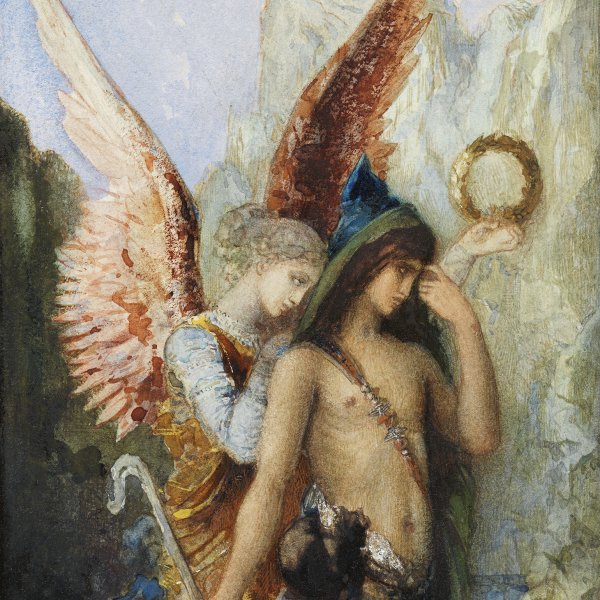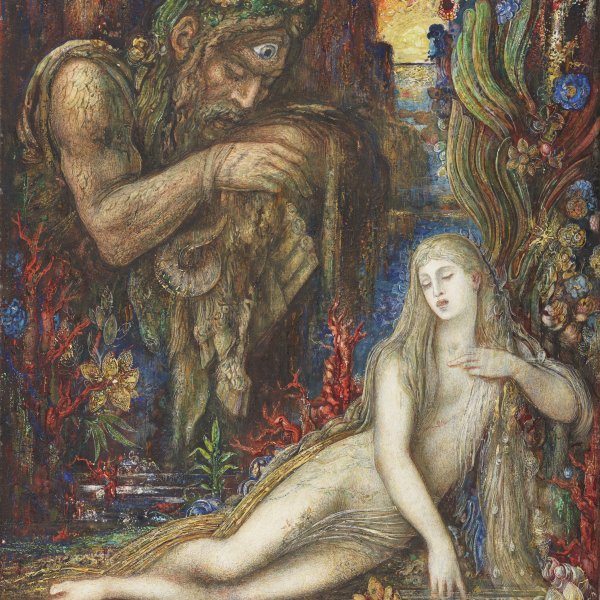Gustave Moreau
Paris, 1826-1898
The French painter Gustave Moreau, who had a Romantic grounding and a thorough knowledge of the Italian Renaissance painters, developed a personal style that foreshadowed late nineteenth-century French Symbolism. He studied under François-Édouard Picot at the École des Beaux-Arts and exhibited for the first time at the Salon of 1851. His early works, steeped in the Romanticism of Eugène Delacroix and Théodore Chassériau, were well received by the critics, though Moreau was not entirely satisfied with them.
Moreau travelled to Italy in 1857. For the next two years he visited Rome, Florence and Venice and had the opportunity of studying and copying the great Italian Renaissance painters, who had a determining influence on him. After returning to Paris, he worked intensely on Oedipus and the Sphinx (New York, The Metropolitan Museum of Art), for which he earned a medal at the Salon of 1864. Prince Napoléon-Jérôme Bonaparte’s acquisition of this picture contributed decisively to Moreau’s public recognition. Thenceforward mythological themes and religious scenes, always interpreted in a personal manner, became predominant in his production. However, his critical fortunes changed at the end of the 1860s, which led him to rework his style, adopting a Baroque manner linked particularly to Rembrandt.
Salomé Dancing before Herod (Los Angeles, Armand Hammer Collection), shown at the Salon of 1876, was a resounding success. An officer of the Legion of Honour from 1883, Moreau taught at the Académie des Beaux-Arts of the Institut de France from 1888.His liberal method of teaching had a determining influence on his students, among them Henri Matisse and the other Fauve painters. Towards the end of his life, in 1895, he began to remodel his Montmartre home to convert it into a museum, which has housed his work since then.
Moreau travelled to Italy in 1857. For the next two years he visited Rome, Florence and Venice and had the opportunity of studying and copying the great Italian Renaissance painters, who had a determining influence on him. After returning to Paris, he worked intensely on Oedipus and the Sphinx (New York, The Metropolitan Museum of Art), for which he earned a medal at the Salon of 1864. Prince Napoléon-Jérôme Bonaparte’s acquisition of this picture contributed decisively to Moreau’s public recognition. Thenceforward mythological themes and religious scenes, always interpreted in a personal manner, became predominant in his production. However, his critical fortunes changed at the end of the 1860s, which led him to rework his style, adopting a Baroque manner linked particularly to Rembrandt.
Salomé Dancing before Herod (Los Angeles, Armand Hammer Collection), shown at the Salon of 1876, was a resounding success. An officer of the Legion of Honour from 1883, Moreau taught at the Académie des Beaux-Arts of the Institut de France from 1888.His liberal method of teaching had a determining influence on his students, among them Henri Matisse and the other Fauve painters. Towards the end of his life, in 1895, he began to remodel his Montmartre home to convert it into a museum, which has housed his work since then.






